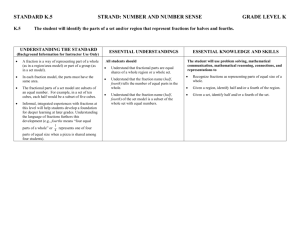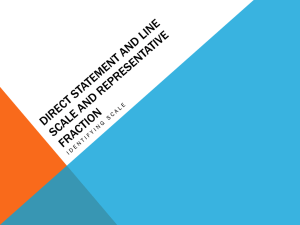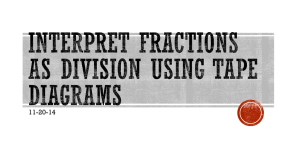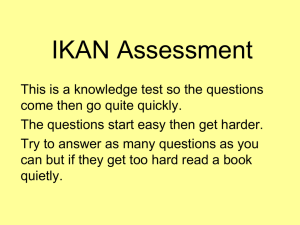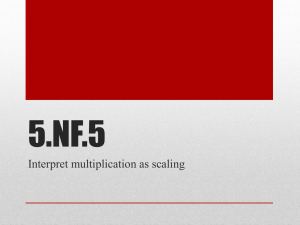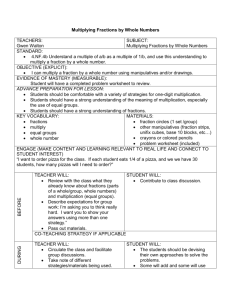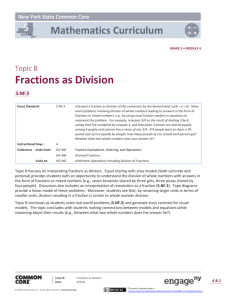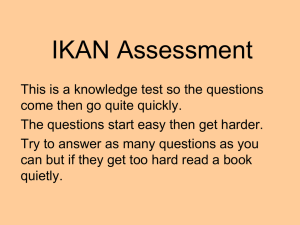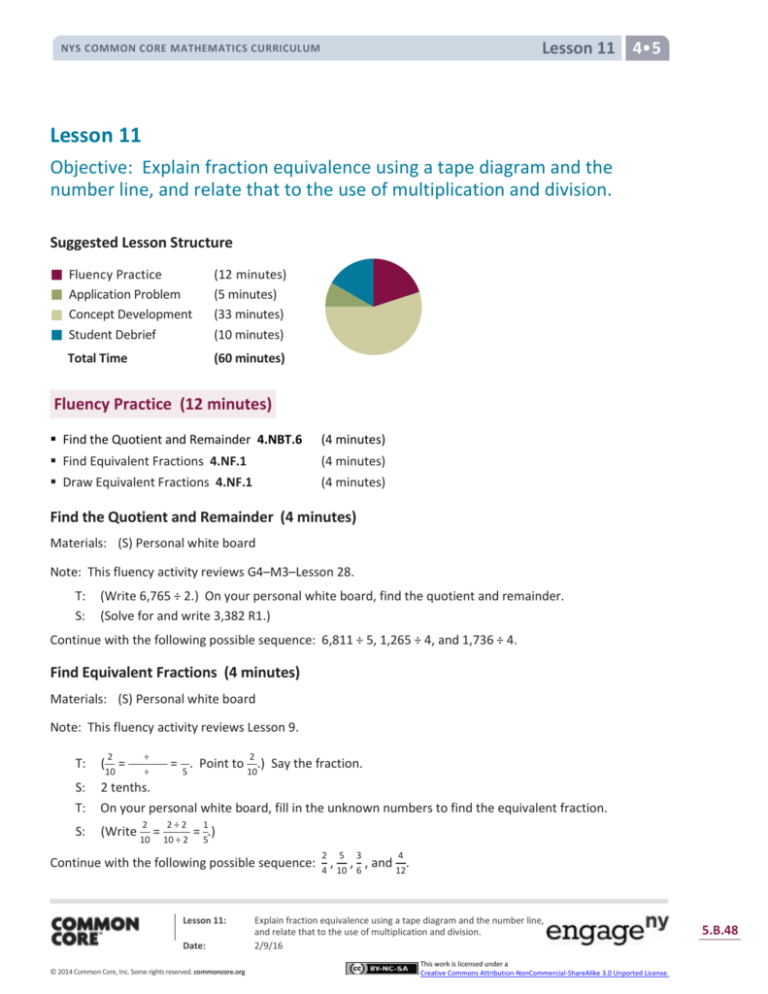
Lesson 11 4 5
NYS COMMON CORE MATHEMATICS CURRICULUM
Lesson 11
Objective: Explain fraction equivalence using a tape diagram and the
number line, and relate that to the use of multiplication and division.
Suggested Lesson Structure
Fluency Practice
Application Problem
Concept Development
Student Debrief
(12 minutes)
(5 minutes)
(33 minutes)
(10 minutes)
Total Time
(60 minutes)
Fluency Practice (12 minutes)
Find the Quotient and Remainder 4.NBT.6
(4 minutes)
Find Equivalent Fractions 4.NF.1
(4 minutes)
Draw Equivalent Fractions 4.NF.1
(4 minutes)
Find the Quotient and Remainder (4 minutes)
Materials: (S) Personal white board
Note: This fluency activity reviews G4–M3–Lesson 28.
T:
S:
(Write 6,765 ÷ 2.) On your personal white board, find the quotient and remainder.
(Solve for and write 3,382 R1.)
Continue with the following possible sequence: 6,811 ÷ 5, 1,265 ÷ 4, and 1,736 ÷ 4.
Find Equivalent Fractions (4 minutes)
Materials: (S) Personal white board
Note: This fluency activity reviews Lesson 9.
2
÷
÷
2
T:
(10 =
S:
2 tenths.
T:
On your personal white board, fill in the unknown numbers to find the equivalent fraction.
S:
(Write 10 = 10 ÷ 2 = 5.)
2
= 5 . Point to 10.) Say the fraction.
2÷2
1
Continue with the following possible sequence:
Lesson 11:
Date:
© 2014 Common Core, Inc. Some rights reserved. commoncore.org
2 5 3
, ,
4 10 6
4
, and 12.
Explain fraction equivalence using a tape diagram and the number line,
and relate that to the use of multiplication and division.
2/9/16
This work is licensed under a
Creative Commons Attribution-NonCommercial-ShareAlike 3.0 Unported License.
5.B.48
Lesson 11 4 5
NYS COMMON CORE MATHEMATICS CURRICULUM
Draw Equivalent Fractions (4 minutes)
Materials: (S) Personal white board
Note: This fluency activity reviews Lesson 10.
T:
(Project a model with 4 out of 10 equal units shaded.) Draw the model, and write the fraction that is
shaded.
S:
(Draw a model with 4 out of 10 equal units shaded. Write 10.)
T:
(Write 10 =
= .) Compose the shaded units into larger units by
÷
circling. Then, complete the number sentence.
S:
(Circle the shaded units into 1 larger unit. Write 10 = 10 ÷ 2 = 5.)
4
4
÷
4
Continue with the following possible sequence:
4 6 8
, ,
6 9 10
4÷2
2
9
, and 12.
Application Problem (5 minutes)
1
8
1
4
3
4
Kelly was baking bread but could only find her cup measuring cup. She needs cup sugar, cup whole
1
1
wheat flour, and 2 cup all-purpose flour. How many 8 cups will she need for each ingredient?
Solution 2
Solution 1
Note: This Application Problem places equivalent fractions into a context that
may be familiar to students. Multiple solution strategies are possible. The first
solution models the equivalency learned in Lessons 7 and 8. The second
solution uses number bonds to find unit fractions, reviewing Topic A content.
Lesson 11:
Date:
© 2014 Common Core, Inc. Some rights reserved. commoncore.org
Explain fraction equivalence using a tape diagram and the number line,
and relate that to the use of multiplication and division.
2/9/16
This work is licensed under a
Creative Commons Attribution-NonCommercial-ShareAlike 3.0 Unported License.
5.B.49
Lesson 11 4 5
NYS COMMON CORE MATHEMATICS CURRICULUM
Concept Development (33 minutes)
Materials: (S) Personal white board, ruler
Problem 1: Use a tape diagram and number line to find equivalent fractions for halves, fourths, and eighths.
T:
S:
T:
S:
T:
Draw a tape diagram to show 1 partitioned
into halves.
(Draw a tape diagram.)
1
Shade 2. Now, decompose halves to make
fourths. How many fourths are shaded?
2 fourths.
On your personal white board, write what we
did as a multiplication number sentence.
1
2
1×2
2×2
2
4
= .)
S:
(Write =
T:
Decompose fourths to make eighths. How many
eighths are shaded?
4 eighths.
Write a multiplication number sentence to show that
2 fourths and 4 eighths are equal.
S:
T:
2
4
2×2
4×2
NOTES ON
MULTIPLE MEANS
OF REPRESENTATION:
4
8
= .)
S:
(Write =
T:
Now, use a ruler to draw a number line slightly longer than
the tape diagram. Label points 0 and 1 so that they align
with the ends of the tape diagram.
(Draw a number line.)
S:
T:
S:
1
Label on the number line. Decompose the
2
number line into fourths. What is equivalent
2
to on the number line?
4
1 2
= .
2 4
We showed that on the tape diagram.
T:
S:
Decompose the number line into eighths.
(Label the eighths.)
T:
What is equal to on the number line?
S:
T:
S:
To preserve the pace of the lesson,
provide a tape diagram and number
line Template for some learners.
Students may also choose to transform
the tape diagram into a number line by
erasing the top line, labeling points,
and extending the endpoints.
4
8
1 4
2 4
= . 4 = 8.
2 8
1
2
4
That also means 2 = 4 = 8.
Explain what happened on the number line as
you decomposed the half.
When we decomposed the half into fourths, it was like sharing a licorice strip with four people
instead of two. We got 4 smaller parts instead of 2 larger parts. There are 4 smaller segments
Lesson 11:
Date:
© 2014 Common Core, Inc. Some rights reserved. commoncore.org
Explain fraction equivalence using a tape diagram and the number line,
and relate that to the use of multiplication and division.
2/9/16
This work is licensed under a
Creative Commons Attribution-NonCommercial-ShareAlike 3.0 Unported License.
5.B.50
Lesson 11 4 5
NYS COMMON CORE MATHEMATICS CURRICULUM
in the whole instead of 2 larger segments. We doubled the number of parts but made smaller
parts, just like with the area model. It made 2 lengths that were the same length as 1 half.
Problem 2: Use a number line, multiplication, and division to decompose and compose fractions.
T:
T:
Partition a number line into thirds. Decompose
1 third into 4 equal parts.
Write a number sentence using multiplication to
show what fraction is equivalent to 1 third on this
number line.
S:
(Write 3 = 3 × 4 = 12.)
T:
S:
T:
Explain to your partner why that is true.
It’s just like the area model. We made more smaller units, but the lengths stayed the same instead
of the area staying the same. If we multiply a numerator and a denominator by the same
number, we find an equivalent fraction. 1 third was decomposed into fourths, so we multiplied
the number of units in the whole and number of selected units by 4.
Write the equivalence as a number sentence using division.
S:
(Write
T:
S:
Explain to your partner why that is true.
We can join four smaller segments to make one longer one that is the same as 1 third. We can
1
1
group the twelfths together to make thirds. Four copies of 12 equals 3. Just like the area
model, we are composing units to make a larger unit.
1
1×4
4
4
4÷4 1
=
= .)
12 12 ÷ 4 3
Problem 3: Decompose a non-unit fraction using a number line and division.
2
T:
Draw a number line. Partition it into fifths, label it, and locate 5.
S:
(Draw.)
T:
T:
Decompose 5 into 6 equal parts. First, discuss your
strategy with your partner.
I will make each fifth into 6 parts. No, we have to
decompose 2 units, not 1 unit. Each unit will be
decomposed into 3 equal parts. Two units are
becoming 6 units. We are multiplying the numerator
and denominator by 3.
Write a number sentence to express the equivalent fractions.
S:
(Write 5 = 5 × 3 = 15.)
S:
2
2
2×3
6
Lesson 11:
Date:
© 2014 Common Core, Inc. Some rights reserved. commoncore.org
Explain fraction equivalence using a tape diagram and the number line,
and relate that to the use of multiplication and division.
2/9/16
This work is licensed under a
Creative Commons Attribution-NonCommercial-ShareAlike 3.0 Unported License.
5.B.51
NYS COMMON CORE MATHEMATICS CURRICULUM
Lesson 11 4 5
Problem Set (10 minutes)
Students should do their personal best to complete the Problem Set within the allotted 10 minutes. For
some classes, it may be appropriate to modify the assignment by specifying which problems they work on
first. Some problems do not specify a method for solving. Students should solve these problems using the
RDW approach used for Application Problems.
Student Debrief (10 minutes)
Lesson Objective: Explain fraction equivalence using a tape
diagram and the number line, and relate that to the use of
multiplication and division.
The Student Debrief is intended to invite reflection and active
processing of the total lesson experience.
Invite students to review their solutions for the Problem Set.
They should check work by comparing answers with a partner
before going over answers as a class. Look for misconceptions
or misunderstandings that can be addressed in the Debrief.
Guide students in a conversation to debrief the Problem Set and
process the lesson.
NOTES ON
MULTIPLE MEANS
OF ENGAGEMENT:
Challenge students working above
grade level and others to discuss or
journal about the three models used
for finding equivalent fractions. Ask,
“How do the tape diagram and number
line relate to one another? When
might you choose to use a number line
rather than an area model? Why?”
Any combination of the questions below may be used to
lead the discussion.
In Problem 1, compare the distance from 0 to
each point on the number line you circled. What
do you notice?
In Problem 1, does the unshaded portion of the
tape diagram represent the same length from the
point to 1 on every number line? How do you
know?
Compare your number sentences in Problem 2.
Could they be rewritten using division?
In Problem 5, what new units were created when
2 fifths was decomposed into 4 equal parts?
How is modeling with a number line similar to
modeling with an area model? How is it
different?
In Grade 3, you found equivalent fractions by
locating them on a number line. Do you now
require a number line to find equivalent
fractions? What other ways can you determine
equivalent fractions?
Lesson 11:
Date:
© 2014 Common Core, Inc. Some rights reserved. commoncore.org
Explain fraction equivalence using a tape diagram and the number line,
and relate that to the use of multiplication and division.
2/9/16
This work is licensed under a
Creative Commons Attribution-NonCommercial-ShareAlike 3.0 Unported License.
5.B.52
NYS COMMON CORE MATHEMATICS CURRICULUM
Lesson 11 4 5
Exit Ticket (3 minutes)
After the Student Debrief, instruct students to complete
the Exit Ticket. A review of their work will help with
assessing students’ understanding of the concepts that
were presented in today’s lesson and planning more
effectively for future lessons. The questions may be read
aloud to the students.
Lesson 11:
Date:
© 2014 Common Core, Inc. Some rights reserved. commoncore.org
Explain fraction equivalence using a tape diagram and the number line,
and relate that to the use of multiplication and division.
2/9/16
This work is licensed under a
Creative Commons Attribution-NonCommercial-ShareAlike 3.0 Unported License.
5.B.53
NYS COMMON CORE MATHEMATICS CURRICULUM
Name
Lesson 11 Problem Set 4 5
Date
1. Label each number line with the fractions shown on the tape diagram. Circle the fraction that labels the
point on the number line that also names the selected part of the tape diagram.
a.
1
b.
1
c.
1
2. Write number sentences using multiplication to show:
a. The fraction represented in 1(a) is equivalent to the fraction represented in 1(b).
b. The fraction represented in 1(a) is equivalent to the fraction represented in 1(c).
Lesson 11:
Date:
© 2014 Common Core, Inc. Some rights reserved. commoncore.org
Explain fraction equivalence using a tape diagram and the number line,
and relate that to the use of multiplication and division.
2/9/16
This work is licensed under a
Creative Commons Attribution-NonCommercial-ShareAlike 3.0 Unported License.
5.B.54
Lesson 11 Problem Set 4 5
NYS COMMON CORE MATHEMATICS CURRICULUM
3. Use each shaded tape diagram below as a ruler to draw a number line. Mark each number line with the
fractional units shown on the tape diagram, and circle the fraction that labels the point on the number
line that also names the selected part of the tape diagram.
1
a.
1
b.
1
c.
4. Write number sentences using division to show:
a. The fraction represented in 3(a) is equivalent to the fraction represented in 3(b).
b. The fraction represented in 3(a) is equivalent to the fraction represented in 3(c).
2
5. a. Partition a number line from 0 to 1 into fifths. Decompose 5 into 4 equal lengths.
b. Write a number sentence using multiplication to show what fraction represented on the number line
2
is equivalent to 5.
c. Write a number sentence using division to show what fraction represented on the number line is
2
equivalent to 5.
Lesson 11:
Date:
© 2014 Common Core, Inc. Some rights reserved. commoncore.org
Explain fraction equivalence using a tape diagram and the number line,
and relate that to the use of multiplication and division.
2/9/16
This work is licensed under a
Creative Commons Attribution-NonCommercial-ShareAlike 3.0 Unported License.
5.B.55
Lesson 11 Exit Ticket 4 5
NYS COMMON CORE MATHEMATICS CURRICULUM
Name
Date
2
1. Partition a number line from 0 to 1 into sixths. Decompose 6 into 4 equal lengths.
2. Write a number sentence using multiplication to show what fraction represented on the number line is
2
6
equivalent to .
3. Write a number sentence using division to show what fraction represented on the number line is
2
6
equivalent to .
Lesson 11:
Date:
© 2014 Common Core, Inc. Some rights reserved. commoncore.org
Explain fraction equivalence using a tape diagram and the number line,
and relate that to the use of multiplication and division.
2/9/16
This work is licensed under a
Creative Commons Attribution-NonCommercial-ShareAlike 3.0 Unported License.
5.B.56
NYS COMMON CORE MATHEMATICS CURRICULUM
Name
Lesson 11 Homework 4 5
Date
1. Label each number line with the fractions shown on the tape diagram. Circle the fraction that labels the
point on the number line that also names the selected part of the tape diagram.
a.
b.
c.
2. Write number sentences using multiplication to show:
a. The fraction represented in 1(a) is equivalent to the fraction represented in 1(b).
b. The fraction represented in 1(a) is equivalent to the fraction represented in 1(c).
Lesson 11:
Date:
© 2014 Common Core, Inc. Some rights reserved. commoncore.org
Explain fraction equivalence using a tape diagram and the number line,
and relate that to the use of multiplication and division.
2/9/16
This work is licensed under a
Creative Commons Attribution-NonCommercial-ShareAlike 3.0 Unported License.
5.B.57
Lesson 11 Homework 4 5
NYS COMMON CORE MATHEMATICS CURRICULUM
3. Use each shaded tape diagram below as a ruler to draw a number line. Mark each number line with the
fractional units shown on the tape diagram, and circle the fraction that labels the point on the number
line that also names the selected part of the tape diagram.
1
a.
1
b.
1
c.
4. Write a number sentence using division to show the fraction represented in 3(a) is equivalent to the
fraction represented in 3(b).
3
5. a. Partition a number line from 0 to 1 into fourths. Decompose 4 into 6 equal lengths.
b. Write a number sentence using multiplication to show what fraction represented on the number line
3
is equivalent to 4.
c. Write a number sentence using division to show what fraction represented on the number line is
3
4
equivalent to .
Lesson 11:
Date:
© 2014 Common Core, Inc. Some rights reserved. commoncore.org
Explain fraction equivalence using a tape diagram and the number line,
and relate that to the use of multiplication and division.
2/9/16
This work is licensed under a
Creative Commons Attribution-NonCommercial-ShareAlike 3.0 Unported License.
5.B.58

